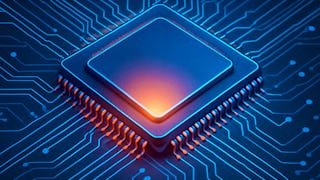This course delves into software development topics such as working with Arm C/C++ compilers and Arm debug tools to optimize your software, whether it's for performance or code size. This course also looks more closely at the Common Microcontroller Software Interface Standard and how it helps ensure that software targeted at Cortex-M devices can be written using a consistent approach.

Enjoy unlimited growth with a year of Coursera Plus for $199 (regularly $399). Save now.

Cortex-M Software Development Fundamentals
This course is part of Arm Cortex-M Architecture and Software Development Specialization



Instructors: Uma Maheswari Ramalingam
4,582 already enrolled
Included with
(35 reviews)
What you'll learn
Compile and link Cortex-M applications using mandatory, recommended and commonly-used switches.
Debug and trace a Cortex-M application running on a Cortex-M device.
Boot and initialize a Cortex-M system using standard programming techniques.
Skills you'll gain
Details to know

Add to your LinkedIn profile
4 assignments
See how employees at top companies are mastering in-demand skills

Build your subject-matter expertise
- Learn new concepts from industry experts
- Gain a foundational understanding of a subject or tool
- Develop job-relevant skills with hands-on projects
- Earn a shareable career certificate

There are 5 modules in this course
This course delves into software development topics such as working with Arm C/C++ compilers and Arm debug tools to optimize your software, whether it's for performance or code size. This course also looks more closely at the Common Microcontroller Software Interface Standard and how it helps ensure that software targeted at Cortex-M devices can be written using a consistent approach.This module describes the essential compiler and linker options required in order to develop applications targeted at different Arm embedded systems. The presentation includes information about Arm Compiler for Embedded and the GNU toolchain.
What's included
1 video
What's included
19 videos8 readings1 assignment
This module describes the debug and trace features available in the Armv8-M Mainline architecture.
What's included
10 videos1 reading1 assignment
The Booting and Initialization module takes you through essential startup code that can ensure that the processor and system are configured and initialised appropriately before the 'main' function is reached in the C program.
What's included
19 videos1 reading1 assignment
This module introduces Tarmac trace from Fast Models, and uses that to walk through everything a Cortex-M3 device would do if used with CMSIS code from Reset to the main() function, to triggering an interrupt using the NVIC. Although the module is related to a Cortex-M3 device, the details presented also apply to any Armv7-M / Armv8-M device, acting as a recap of all the content covered in this M-profile course.
What's included
11 videos4 readings1 assignment
Earn a career certificate
Add this credential to your LinkedIn profile, resume, or CV. Share it on social media and in your performance review.
Instructors


Offered by
Explore more from Software Development
 Status: Free Trial
Status: Free Trial Status: Free Trial
Status: Free Trial Status: Free Trial
Status: Free Trial Status: Free Trial
Status: Free Trial
Why people choose Coursera for their career




Frequently asked questions
To access the course materials, assignments and to earn a Certificate, you will need to purchase the Certificate experience when you enroll in a course. You can try a Free Trial instead, or apply for Financial Aid. The course may offer 'Full Course, No Certificate' instead. This option lets you see all course materials, submit required assessments, and get a final grade. This also means that you will not be able to purchase a Certificate experience.
When you enroll in the course, you get access to all of the courses in the Specialization, and you earn a certificate when you complete the work. Your electronic Certificate will be added to your Accomplishments page - from there, you can print your Certificate or add it to your LinkedIn profile.
Yes. In select learning programs, you can apply for financial aid or a scholarship if you can’t afford the enrollment fee. If fin aid or scholarship is available for your learning program selection, you’ll find a link to apply on the description page.
More questions
Financial aid available,










